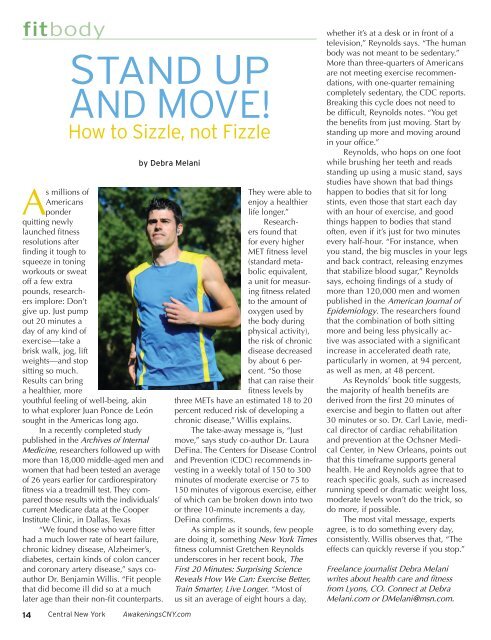Natural Awakenings
Natural Awakenings
Natural Awakenings
Create successful ePaper yourself
Turn your PDF publications into a flip-book with our unique Google optimized e-Paper software.
fitbody<br />
14<br />
STAND UP<br />
AND MOVE!<br />
How to Sizzle, not Fizzle<br />
As millions of<br />
Americans<br />
ponder<br />
quitting newly<br />
launched fitness<br />
resolutions after<br />
finding it tough to<br />
squeeze in toning<br />
workouts or sweat<br />
off a few extra<br />
pounds, researchers<br />
implore: Don’t<br />
give up. Just pump<br />
out 20 minutes a<br />
day of any kind of<br />
exercise—take a<br />
brisk walk, jog, lift<br />
weights—and stop<br />
sitting so much.<br />
Results can bring<br />
a healthier, more<br />
youthful feeling of well-being, akin<br />
to what explorer Juan Ponce de León<br />
sought in the Americas long ago.<br />
In a recently completed study<br />
published in the Archives of Internal<br />
Medicine, researchers followed up with<br />
more than 18,000 middle-aged men and<br />
women that had been tested an average<br />
of 26 years earlier for cardiorespiratory<br />
fitness via a treadmill test. They compared<br />
those results with the individuals’<br />
current Medicare data at the Cooper<br />
Institute Clinic, in Dallas, Texas<br />
“We found those who were fitter<br />
had a much lower rate of heart failure,<br />
chronic kidney disease, Alzheimer’s,<br />
diabetes, certain kinds of colon cancer<br />
and coronary artery disease,” says coauthor<br />
Dr. Benjamin Willis. “Fit people<br />
that did become ill did so at a much<br />
later age than their non-fit counterparts.<br />
by debra melani<br />
Central New York <strong>Awakenings</strong>CNY.com<br />
They were able to<br />
enjoy a healthier<br />
life longer.”<br />
Researchers<br />
found that<br />
for every higher<br />
MET fitness level<br />
(standard metabolic<br />
equivalent,<br />
a unit for measuring<br />
fitness related<br />
to the amount of<br />
oxygen used by<br />
the body during<br />
physical activity),<br />
the risk of chronic<br />
disease decreased<br />
by about 6 percent.<br />
“So those<br />
that can raise their<br />
fitness levels by<br />
three METs have an estimated 18 to 20<br />
percent reduced risk of developing a<br />
chronic disease,” Willis explains.<br />
The take-away message is, “Just<br />
move,” says study co-author Dr. Laura<br />
DeFina. The Centers for Disease Control<br />
and Prevention (CDC) recommends investing<br />
in a weekly total of 150 to 300<br />
minutes of moderate exercise or 75 to<br />
150 minutes of vigorous exercise, either<br />
of which can be broken down into two<br />
or three 10-minute increments a day,<br />
DeFina confirms.<br />
As simple as it sounds, few people<br />
are doing it, something New York Times<br />
fitness columnist Gretchen Reynolds<br />
underscores in her recent book, The<br />
First 20 Minutes: Surprising Science<br />
Reveals How We Can: Exercise Better,<br />
Train Smarter, Live Longer. “Most of<br />
us sit an average of eight hours a day,<br />
whether it’s at a desk or in front of a<br />
television,” Reynolds says. “The human<br />
body was not meant to be sedentary.”<br />
More than three-quarters of Americans<br />
are not meeting exercise recommendations,<br />
with one-quarter remaining<br />
completely sedentary, the CDC reports.<br />
Breaking this cycle does not need to<br />
be difficult, Reynolds notes. “You get<br />
the benefits from just moving. Start by<br />
standing up more and moving around<br />
in your office.”<br />
Reynolds, who hops on one foot<br />
while brushing her teeth and reads<br />
standing up using a music stand, says<br />
studies have shown that bad things<br />
happen to bodies that sit for long<br />
stints, even those that start each day<br />
with an hour of exercise, and good<br />
things happen to bodies that stand<br />
often, even if it’s just for two minutes<br />
every half-hour. “For instance, when<br />
you stand, the big muscles in your legs<br />
and back contract, releasing enzymes<br />
that stabilize blood sugar,” Reynolds<br />
says, echoing findings of a study of<br />
more than 120,000 men and women<br />
published in the American Journal of<br />
Epidemiology. The researchers found<br />
that the combination of both sitting<br />
more and being less physically active<br />
was associated with a significant<br />
increase in accelerated death rate,<br />
particularly in women, at 94 percent,<br />
as well as men, at 48 percent.<br />
As Reynolds’ book title suggests,<br />
the majority of health benefits are<br />
derived from the first 20 minutes of<br />
exercise and begin to flatten out after<br />
30 minutes or so. Dr. Carl Lavie, medical<br />
director of cardiac rehabilitation<br />
and prevention at the Ochsner Medical<br />
Center, in New Orleans, points out<br />
that this timeframe supports general<br />
health. He and Reynolds agree that to<br />
reach specific goals, such as increased<br />
running speed or dramatic weight loss,<br />
moderate levels won’t do the trick, so<br />
do more, if possible.<br />
The most vital message, experts<br />
agree, is to do something every day,<br />
consistently. Willis observes that, “The<br />
effects can quickly reverse if you stop.”<br />
Freelance journalist Debra Melani<br />
writes about health care and fitness<br />
from Lyons, CO. Connect at Debra<br />
Melani.com or DMelani@msn.com.


